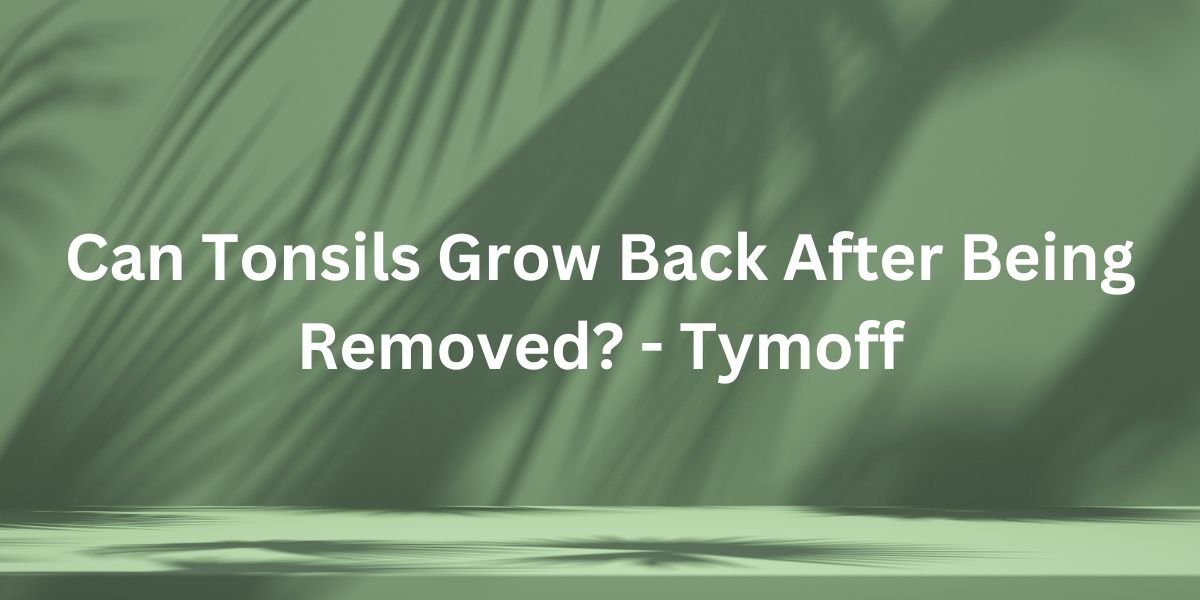
Can Tonsils Grow Back After Being Removed? – Tymoff
Just when you thought you were done with those pesky tonsils, they might decide to make a comeback! The question on everyone’s mind is: Can Tonsils Grow Back After Being Removed? – Tymoff? Let’s dive into the facts and myths surrounding this intriguing topic on Tymoff.
Introduction to Tonsils and their function
The tonsils are two small, oval-shaped masses of tissue located at the back of the throat on either side. They are part of the lymphatic system and play an important role in our body’s immune defense. Tonsils can vary in size and shape, but their function remains the same – to protect us from harmful bacteria and viruses.
When we think about our tonsils, we often associate them with sore throats and infections. However, they actually serve as the first line of defense against pathogens that enter through our mouth and nose. The tonsils contain specialized cells called lymphocytes, which produce antibodies to fight off infections.
Besides producing antibodies, the tonsils also act as a filter for harmful substances that enter our body through air or food. They trap these particles before they can reach other parts of our body. This is particularly crucial during childhood when children are exposed to various germs while exploring their environment.
Furthermore, the tonsils also have immune memory cells that help recognize previous infections and activate a quick response to prevent future infections. This means that once you have recovered from a particular infection, your tonsils will remember it and be better equipped to defend against it if exposed again.
Another essential function of the tonsils is to produce white blood cells known as lymphocytes that fight off cancerous cells in the throat area. These lymphocytes work together with other immune cells to identify and destroy abnormal or infected cells before they can cause harm.
While these functions make it seem like removing your tonsils would be detrimental to your health, there are cases where removal may be necessary. Recurring or chronic infections such as strep throat or sleep apnea caused by enlarged tonsils may require surgical removal (tonsillectomy) for proper treatment.
However, contrary to popular belief, removing the tonsils does not leave you more susceptible to infections. Other parts of our immune system take over their functions after removal. In fact, studies have shown that individuals who have had their tonsils removed may experience fewer throat infections in the long run.
The tonsils play a vital role in protecting our body from infections and maintaining overall health. While they may sometimes require removal due to certain conditions, it is essential to understand their functions and importance in our immune system.
Read More: The 1982 Movie Poltergeist Used Real Skeletons As – Tymoff
Reasons for Tonsil Removal Surgery
Tonsil removal surgery, also known as a tonsillectomy, is a common procedure performed to remove the tonsils from the back of the throat. While it may seem like an extreme measure, there are various reasons why a person may need to have their tonsils removed.
- Recurrent Tonsillitis
The most common reason for undergoing a tonsillectomy is recurrent or chronic tonsillitis. This condition occurs when the tonsils become inflamed and infected due to bacterial or viral infections. Symptoms include sore throat, difficulty swallowing, fever, and swollen lymph nodes in the neck. If someone experiences multiple episodes of this infection in a year, despite proper treatment with antibiotics, their doctor may recommend removing the tonsils.
- Enlarged Tonsils
Some people naturally have larger than average sized tonsils, which can cause breathing difficulties during sleep. When enlarged tonsils block the airway at night, it can lead to snoring and sleep apnea (pauses in breathing while asleep). In children especially, this can result in behavioral problems and poor academic performance due to disrupted sleep patterns. In such cases, doctors often recommend removing the tonsils to improve airflow and alleviate these symptoms.
- Abscess Formation
An abscess refers to a collection of pus within tissues caused by an infection that has not been effectively treated with antibiotics. It commonly occurs in the peritonsillar region (around one of both sides of the throat) and causes severe pain on one side while swallowing or speaking. An abscess requires immediate medical attention as it can lead to difficulty breathing if left untreated for long periods. In some cases where repeated abscesses occur despite treatment attempts, doctors may suggest removing the affected tonsil(s).
4. Cancerous Growth
Although rare, cancerous growths can develop in either one or both of your tonsils leading to malignancy requiring prompt removal. The most common type of cancer affecting the tonsils is squamous cell carcinoma, which typically presents as a painless lump in the back of the throat. Other symptoms include difficulty swallowing, ear pain, and changes in voice. If diagnosed early enough, surgery can be curative for this condition.
While tonsillectomy is not always necessary, it remains an effective treatment option for various conditions that affect the tonsils. If you experience recurrent or chronic infections, enlarged tonsils causing breathing difficulties, abscess formation, or have a suspicion of cancerous growths in your throat region; consulting with your doctor about a possible tonsil removal surgery may be beneficial to improve your overall health and quality of life.
Can Tonsils Grow Back After Being Removed? – Tymoff: Myth vs. Reality
When it comes to tonsil removal, there is a common misconception that they can grow back after being surgically removed. This leads to the question – can tonsils really grow back? Let’s take a look at the myth and reality behind this belief.
The Myth:
Many people believe that tonsils can grow back even after they have been surgically removed. This belief often stems from personal experiences or stories heard from others. It is also fueled by the fact that some individuals may experience recurring infections or symptoms similar to those of tonsillitis, leading them to assume that their tonsils have regrown.
The Reality:
Contrary to popular belief, once your tonsils are removed, they do not grow back. During a surgical procedure known as a tonsillectomy, the entire tonsil tissue is removed from its root in order to prevent any recurrence of infections or other health issues related to enlarged or infected tonsils.
However, what can sometimes happen is the regrowth of small bits of tissue called “tonsillar remnants”. These are tiny fragments of tissue left behind during the surgery which may be mistaken for actual regrowth of the entire tonsil. While these remnants may cause concern for some individuals due to their appearance and potential for causing discomfort, they are harmless and do not require any further treatment.
It is important to note that in very rare cases (less than 1%), there have been instances where larger portions of the remaining tissue have grown back after a few months or even years following a tonsillectomy. This condition is known as “regrowth” and requires medical attention if it causes any symptoms such as difficulty swallowing or breathing.
Factors Influencing Tonsil Regrowth:
There are certain factors that can contribute to the rare occurrence of tonsil regrowth after removal:
- Surgeon’s Technique: The skill and technique used by your surgeon during the procedure play an important role in preventing any regrowth of tonsil tissue.
- Age: Tonsils are more likely to grow back in younger individuals as their bodies have a higher capacity for regeneration and healing.
- Genetics: Some people may have a genetic predisposition to regrow tonsil tissue after removal, making them more susceptible to this rare occurrence.
While it is a common belief that tonsils can grow back after being removed, the reality is that they do not. In some rare cases, small remnants may be mistaken for regrowth but do not require any further treatment. It is important to consult with your doctor if you experience any symptoms or concerns regarding your tonsils after a surgical procedure.
Read More: It is not Wisdom But Authority That Makes a Law. T – Tymoff
Factors that Affect the Regrowth of Tonsils
The tonsils, located at the back of our throat, are a part of our immune system that help to fight off infections. However, in some cases, they can become infected themselves and cause discomfort and pain. In such cases, the removal of tonsils may be recommended by a doctor.
But can tonsils grow back after being removed? The answer is yes and no. While it is possible for some tissue to regrow after a tonsillectomy (removal of the tonsils), it is highly unlikely for them to fully regenerate.
There are several factors that can affect the regrowth of tonsils after a surgical procedure:
- Age: Age plays a significant role in the regrowth of tonsils. Children who undergo a tonsillectomy have a higher chance of their tonsils growing back compared to adults. This is because children’s bodies are still developing and have more active cells that facilitate healing and regeneration.
- Surgical Technique: The technique used during surgery can also impact the likelihood of tonsil regrowth. Traditional methods involve the complete removal of the entire tonsil with minimal tissue remaining, making it less likely for them to grow back. On the other hand, if partial removal or laser techniques are used, there may be remaining tissue left behind which could lead to regrowth.
- Healing Process: The healing process also plays an essential role in whether or not your tonsils will grow back. If proper care is not taken during recovery, such as smoking or eating spicy foods that irritate the throat, it can lead to inflammation and promote tissue growth.
- Genetics: Some studies suggest that genetics play a role in determining whether or not someone’s tonsils will grow back after being removed. People with family members who have had their tonsils grow back are more likely to experience similar circumstances.
- Quality of Surgery: It is crucial to choose an experienced surgeon when considering a tonsillectomy. A poorly performed surgery can result in incomplete removal, leaving room for the remaining tissue to regrow.
While it is possible for some tissue to regrow after a tonsillectomy, it is highly unlikely for them to fully regenerate. Factors such as age, surgical technique, healing process, genetics and quality of surgery can all affect the regrowth of tonsils. It is essential to consult with your doctor before making any decisions about removing your tonsils and ensure proper post-surgery care for a successful recovery.
Symptoms of Regrowing Tonsils
After undergoing a tonsillectomy, the surgical removal of the tonsils, it is not uncommon for some people to experience what seems like regrowth of their tonsils. This can be confusing and concerning, as many patients are under the impression that once their tonsils are removed, they will never grow back. However, it is possible for some tissue to regrow in the area where the tonsils were removed.
Here are some common symptoms that may indicate regrowing tonsils:
- Sore Throat: One of the most common symptoms of regrowing tonsils is a sore throat. This can be caused by inflammation and irritation in the area where the tissue is growing back. The soreness may also be accompanied by difficulty swallowing or discomfort when talking.
- Difficulty Swallowing: As mentioned above, difficulty swallowing can be a result of enlarged or inflamed regrown tissue in the place where your tonsils used to be. This can make it challenging to eat or drink comfortably.
- Bad Breath: When tissue grows back after a tonsillectomy, it creates small pockets where food particles and bacteria can get trapped. These pockets can lead to bad breath if not cleaned properly.
- Ear Pain: The sensation of pain in your ears may also occur due to regrowing tissue pressing on nearby nerves or causing referred pain from your throat.
- Red or White Spots on Tonsillar Area: If you open your mouth wide and look at the spot where your tonsils used to be, you may notice small red or white spots surrounding the area where new tissue has grown back.
It’s essential to note that these symptoms do not necessarily mean that your entire tonsil has grown back; rather, it could be small pockets of lymphoid tissues called “tonsillar remnants.” These remnants usually do not cause any significant problems but may become enlarged and cause discomfort.
If you experience any of the above symptoms after a tonsillectomy, it’s crucial to consult your doctor. They will be able to assess the situation and determine if further treatment is needed. In some cases, a second surgery may be necessary to remove the regrown tissue or remnants completely.
While it is uncommon for tonsils to grow back entirely after being removed, it is possible for some tissue to regrow in the area. If you are experiencing any symptoms that may indicate this, don’t hesitate to seek medical advice for proper evaluation and treatment.
Read More: A True Relationship is Two Imperfect People Refusi – Tymoff
Treatment Options for Regrowth of Tonsils
Tonsillectomy, or the surgical removal of tonsils, was a common procedure for treating recurrent infections and breathing problems in the past. However, with advancements in medical technology and understanding of the role of tonsils in our immune system, there has been a shift towards preserving them whenever possible. This has raised the question: can tonsils grow back after being removed?
While it is not common for tonsils to regrow after they have been completely removed through surgery, there have been cases where small amounts of tissue may regrow over time. This is known as residual tissue or remnants and does not necessarily mean that the entire tonsil has grown back.
In cases where there is significant regrowth of tonsil tissue, it may cause symptoms similar to those experienced before their removal such as sore throat, difficulty swallowing, and ear discomfort. Regrowth usually occurs within the first 12 months after surgery but can happen up to several years later.
If you are experiencing these symptoms after having your tonsils removed, it is important to consult with your doctor for a proper evaluation. They will conduct a physical exam and may also perform imaging tests such as CT scans or ultrasound to determine if there is any regrowth present.
The treatment options for regrown tonsil tissue depend on its size and location. If it is small and not causing any significant symptoms or complications, your doctor may recommend regular monitoring and observation. However, if it is causing discomfort or interfering with daily activities, further intervention may be necessary.
One option for treating larger regrown tissues is a procedure called coblation cryptolysis. This involves using radiofrequency energy to shrink the enlarged tissue without completely removing it. It is less invasive than traditional tonsillectomy surgery and can be done on an outpatient basis.
In cases where there are recurrent infections or severe symptoms due to regrown tissues, complete removal of the affected area may be necessary through another round of tonsillectomy. This is usually reserved for cases where the regrowth is causing significant problems and other treatment options have been exhausted.
In addition to these medical treatments, there are also some natural remedies that can help alleviate discomfort caused by regrown tonsils. These include gargling with salt water, drinking warm fluids, and using throat lozenges or sprays.
While it is rare for tonsils to grow back after being removed through surgery, residual tissue or remnants may sometimes appear. If you experience symptoms of regrown tissues, it is important to consult with your doctor for proper evaluation and management. With the right treatment approach, symptoms can be effectively managed and quality of life can be improved.
Tips to Prevent the Regrowth of Tonsils
Tonsillectomy, the surgical removal of tonsils, is a common procedure for individuals who suffer from recurring tonsillitis or other related health issues. While it is an effective treatment method, some people may wonder if their tonsils can grow back after being removed. The short answer is no – once the tonsils are removed, they cannot grow back. However, there are cases where the tissue in the throat area can regrow and cause similar symptoms to those experienced with enlarged or infected tonsils. In this section, we will discuss some tips to prevent the regrowth of tonsils and avoid any potential complications.
- Follow Post-Surgery Care Instructions:
After undergoing a tonsillectomy, it is essential to carefully follow your doctor’s post-surgery care instructions to ensure proper healing and prevent any complications. These instructions typically include avoiding strenuous activities and eating soft foods for a few days after surgery. It is also crucial to take prescribed pain medication and complete any follow-up appointments as advised by your doctor. - Maintain Good Oral Hygiene:
Good oral hygiene plays a significant role in preventing any infections or bacteria that may lead to tissue regrowth in the throat area after a tonsillectomy. Make sure you brush your teeth twice a day and floss regularly to keep your mouth clean and free from harmful bacteria. - Avoid Irritating Foods:
After having a tonsillectomy, it is best to avoid spicy or acidic foods that can irritate the throat and potentially slow down the healing process. These types of food can also increase mucus production in the throat, which can affect tissue regeneration. - Quit Smoking:
Smoking not only damages your overall health but also increases your chances of developing infections in the throat area after a surgery like tonselectomy. Nicotine can constrict blood vessels and reduce oxygen flow to cells that promote healing; therefore, quitting smoking is essential for a speedy recovery and to prevent tissue regrowth. - Stay Hydrated:
Drinking plenty of water after a tonsillectomy can help keep your throat moist, preventing any irritation or discomfort. Adequate hydration can also help flush out any bacteria or toxins that may cause infections in the throat area. - Monitor for Any Recurring Symptoms:
Despite following all the necessary precautions, if you experience any recurring symptoms such as sore throat, difficulty swallowing, or bad breath, consult your doctor immediately. These could be signs of tissue regrowth and require further medical attention.
While it is not possible for tonsils to grow back after being removed, it is essential to take proper care post-surgery to prevent any potential complications or tissue regrowth in the throat area. By following these tips and consulting with your doctor regularly, you can ensure a smooth recovery and maintain good oral health.
Read More: Meet Nala Cat: The Instagram Star With a Ton Of Fo – Tymoff
Conclusion to Can Tonsils Grow Back After Being Removed? – Tymoff
After considering all the information presented in this blog, it is clear that tonsils do not grow back after being completely removed through a tonsillectomy procedure. However, there are instances where small remnants of tonsil tissue may regrow or be left behind during the surgery, which can lead to recurring symptoms and potential complications.
It is crucial to emphasize the importance of carefully monitoring post-tonsillectomy recovery and consulting a doctor if any concerning symptoms arise. This includes keeping track of the healing process, pain levels, and any changes in speech or swallowing patterns. It is also essential to follow all post-operative instructions given by your doctor, such as avoiding strenuous activities and maintaining a proper diet.
Consulting with a doctor is especially critical if you experience any signs of infection such as fever, excessive bleeding, or difficulty breathing. These could indicate an incomplete removal of the tonsils or other underlying issues that require medical attention.
It is also essential to note that children who have undergone a tonsillectomy may need additional care and monitoring during their recovery period. Parents should be vigilant about their child’s post-operative symptoms and consult with their pediatrician if they have any concerns.
In some rare cases, individuals may experience regrowth of their tonsils due to abnormal healing processes known as “regrowth hypertrophy.” This condition typically occurs within six months after the surgery but can happen up to two years later. If you notice symptoms returning after your initial recovery period has passed, it is crucial to seek medical advice promptly.
Furthermore, it must be emphasized that self-diagnosis or relying on online sources for medical advice can be dangerous in these situations. Only a qualified healthcare professional can accurately assess your condition and provide appropriate treatment options.
While complete regrowth of tonsils after undergoing a tonsillectomy is highly unlikely, it is vital to monitor your recovery closely and consult with a doctor if you experience any concerning symptoms. Taking proper care and following your doctor’s instructions can help ensure a successful recovery and prevent potential complications. Remember, always seek medical advice from a professional for any health concerns.



